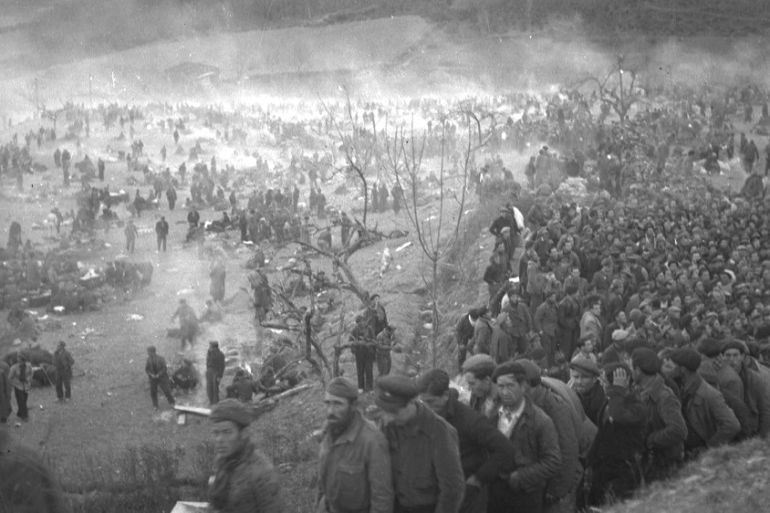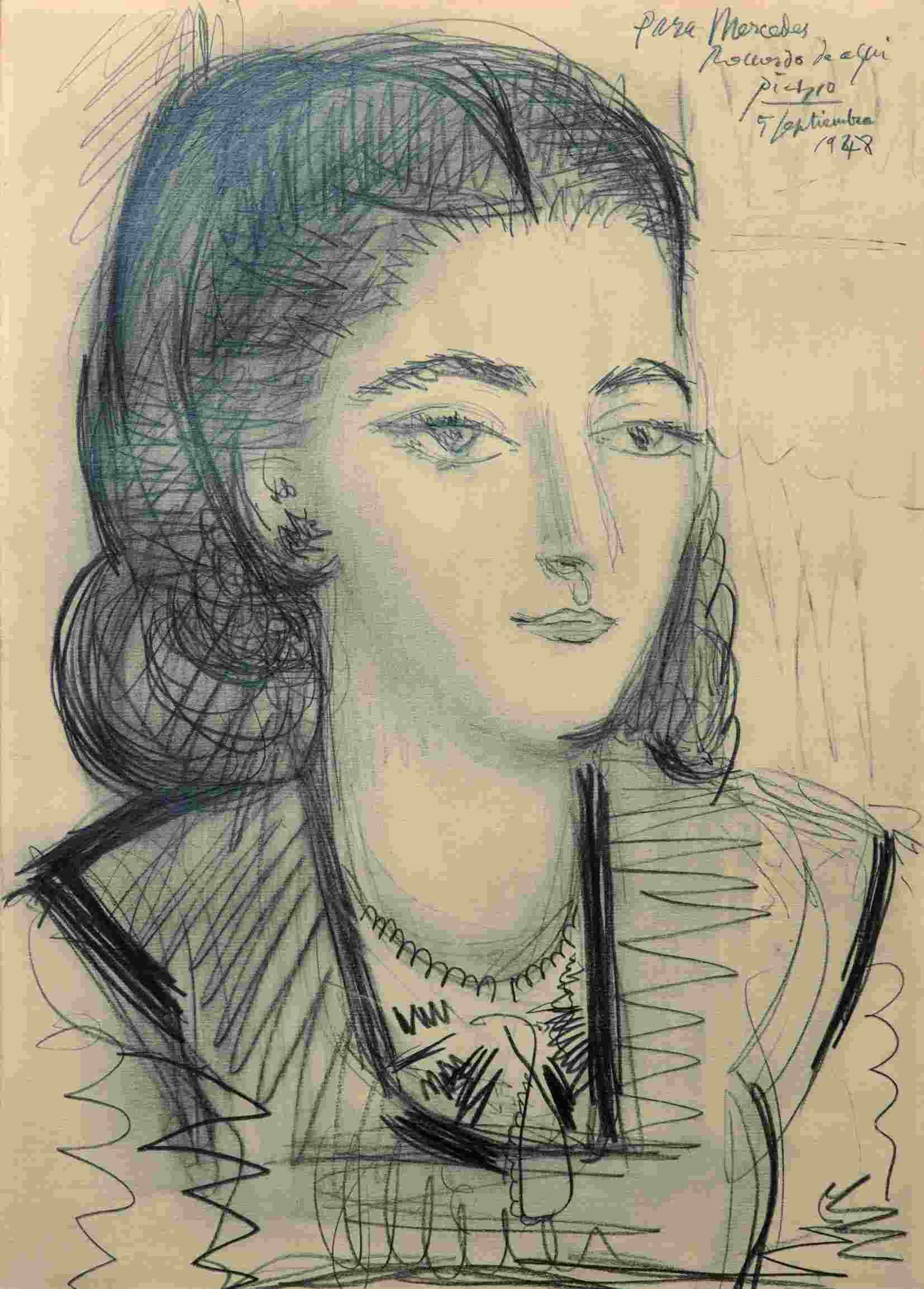Spain’s anti-fascist refugees remembered
Half a million refugees were forced to leave Spain after the civil war was lost to the forces of fascism.

Madrid, Spain – When, as a 13-year-old in 1939, Lina Arconada became one of half a million Spanish Civil War refugees fleeing the troops of the victorious General Franco, she had no idea it would be more than four decades before she could return from France to her home country.
“It was traumatic … we were exhausted, my clothes were in rags, I went to a village cemetery, and hid there for three days,” Arconada recalls, in one of 23 interviews that form part of a huge new exhibition in Madrid entitled: 1939, Spanish Republican Exile.
Keep reading
list of 3 itemsFranco’s victims, stolen from their graves, to be exhumed
Spain’s far right looks to reignite embers of Franco era
With her mother ill and eight months pregnant, her father behind barbed wire in a French internment camp and a five-year-old sister to look after, “I had to learn to be both of my parents at the same time”, she says.
One thing was clear: as her mother faced two separate death sentences from Spanish courts for her political activities as an anarchist, a return was out of the question.
“Some left-wing towns gave us a warm welcome, but in many cases, we found ourselves in a terrible situation,” recounts Antonio Cascarosa, who crossed into France aged 10.
“My father and brother were interned in a camp on a French beach in freezing cold February. The camp had no shelter – nothing. The only way they could try to stay warm was to bury themselves in the sand.”
Dolores Delgado, Spain’s former minister of justice, introduced what is the biggest exhibition to date exploring the legacy of what the Spanish still call “La Retirada” (The Retreat) into France.
“Those in exile were first persecuted, then ridiculed and … the Franco regime tried to wipe out all trace of [their] existence,” she said.
Francisco Franco ruled Spain in a fascist dictatorship from the end of the civil war in 1939 until 1975.
“Eighty years later, democracy [in Spain] is now in a position to settle the moral debt with the victims of Francoism … coming to terms with the past is vital for a better future, even if that past has been atrocious,” added Delgado.
Consisting of three linked exhibitions in the Arco Foundation Centre, and running until the end of February, the hundreds of documents, photos, drawings, books, films and sound recordings on display illustrate how each part of the refugees’ exile merged with the next. The first exhibition covers the crossing of the border, the next focuses on the refugees’ experiences in the internment and concentration camps in France and Germany, the third on the exiles’ diaspora around the globe.
Having fled one appalling, three-year conflict, Spain’s refugees frequently found themselves entwined in an even longer one, set on a global scale: World War II. “After the Retirada, my father fought against the Nazis – and when he was captured, Franco agreed with the Germans to send any Spanish POWs to Mauthausen concentration camp,” says Maggie Perlado, in another exhibition account.

During his five years at the camp, in which two-thirds of the Spanish prisoners died, Perlado’s father formed a resistance network alongside the famous Catalan photographer Francesc Boix. They combined to steal photos taken of SS officers which were subsequently used for their later identification by Boix at the Nuremberg trials.
“When Boix stole a negative, the same evening he’d pass it over to my father (a carpenter), who’d hide it” – risking his life – “inside the legs or mainframes of the cabinets he’d been ordered to make,” recalls Perlado.
The exhibition places a strong emphasis on how the Retirada affected so many ordinary Spanish people, such as Perlado’s father, “because the story that’s mainly been told up to now is those of the big names, painters and writers, more than the others who had to take that road to exile as well”, Dr Idoia Murga Castro, one of the exhibition’s two lead scientific advisers, told Al Jazeera.
“Given all the stories of migration and exile that are happening now, it’s a very timely narrative – partly because of the importance that any human life can have, and partly so we can appreciate that it wasn’t so long ago that we Spanish were in the same predicament.”
Spanning the first four decades of the Retirada – although half the exiles never returned – the combined exhibitions also display plans of the internment camps in France, models of the ships such as the Sinaia which transported 1,500 Republicans to Latin America, as well as BBC radio broadcasts by exiled Spanish novelist Arturo Barea in the 1950s, and even the telegram from Manuel Azana, president of the defeated Republic, confirming his resignation.

While fans of legendary war photographer Robert Capa will appreciate his coverage of the exiles during their first days in France – alongside dozens of previously unpublished photos by French photographer Philippe Gaussot, taken on the frontier in 1939 – art aficionados will be drawn by the Picasso portrait of Mercedes Sanchez Cruz-Lopez, daughter of an exiled government official, and never previously on public display.
A special mention should be made, too, of the photos of the return of Picasso’s Guernica painting, one of the best-known “exiles”, to Spanish soil from New York in 1981.
Large numbers of Republican refugees ended up in Latin America; others fought against the Nazis in the Free French armies, while, as Dr Murga Castro pointed out, Encarnacion Lopez la Argentinita became one of North America’s best-known dancers of the 1940s.
Others went much further afield: Toledo-born artist Alberto Sanchez ended up acting as an adviser in the Soviet Union for Gregori Kozintsev’s 1957 film of Don Quixote, shot – in a bid to reflect the tablelands of central Castille – on the plains of the Russian Crimea. Many, though, sank into decades of relative obscurity, like the Mauthausen photographer Boix, who died in 1951, aged 31, of tuberculosis, probably contracted in the camp.
Yet, while the full tragedy of the Retirada is impossible to ignore in the exhibition, it is clear, too, that the Spanish exiles also contributed to a vast cultural and social enrichment of the countries where they settled.
“There are cases I personally find very moving, like the Paloma Azul dance company in Mexico, which thanks to the support of an American dancer, Anna Sokolov, tried to give a space to all the refugees there to be reunited, to remember Spain and to show the Mexicans their predicament,” says Murga Castro.
“They put on a ballet, Don Lindo de Almeria” – written by a Spanish refugee, Rodolfo Halffter, and which was due to be shown in Spain before his 1939 exile – “and the support and solidarity of the Mexican public gave them a second life; a new hope that fascism could be conquered.”
“We all know how that story ended,” said Murga Castro, with Franco remaining in power for 40 years.
“But in theatre groups like that, the drive to collaborate and overcome fascism was definitely there.”
And 80 years later, the 1939 Exilio Republicano Espanol exhibition pays them homage.